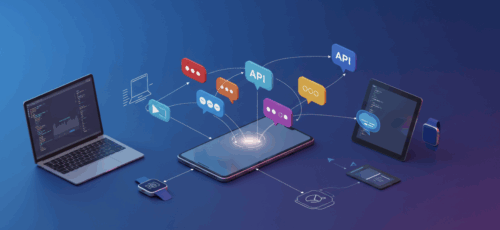The global Voice Chat API market was valued at $1.2 billion in 2024 and is projected to reach $3.5 billion by 2033, representing a staggering 12.5% CAGR. Developers have unprecedented opportunities to build innovative voice-enabled applications that transform how users interact with technology.
Modern voice API integration enables everything from AI-powered customer service bots to real-time transcription services, interactive voice response systems, and seamless WebRTC-based communication platforms. With 76% of developers actively using or planning to implement AI tools in their workflows, understanding how to leverage programmable voice APIs has become a critical skill for building next-generation applications.
This comprehensive guide will walk you through everything you need to know about voice API integration in 2025, from fundamental architecture patterns to advanced implementation strategies that will help you build robust, scalable voice applications.
Understanding Voice API Integration Architecture
Building robust voice applications requires mastering the underlying architecture that connects web applications to global telecommunications networks. Modern voice API integration combines multiple protocols and technologies, each serving specific roles in the communication stack. Understanding these architectural foundations enables developers to make informed decisions about scalability, performance, and integration complexity for their specific use cases.
Core Components of Modern Voice APIs
Voice API integration relies on several foundational technologies working in harmony. Session Initiation Protocol (SIP) serves as the signaling protocol for establishing, modifying, and terminating voice sessions over IP networks. Unlike traditional telephony systems, modern voice APIs leverage SIP’s flexibility to handle everything from simple two-party calls to complex multi-participant conferences.
WebRTC (Web Real-Time Communication) has revolutionized browser-based voice integration. The WebRTC API landscape expanded by 26% in just one year, jumping from 87 interfaces in 2023 to 110 in 2024. This growth reflects the increasing sophistication of browser-based voice capabilities and the need for developers to stay current with evolving standards.
RESTful API architecture forms the backbone of most modern voice platforms, providing stateless communication that scales efficiently. These APIs typically expose endpoints for call control, media handling, number management, and real-time event processing through webhook URLs.
javascript
// Basic voice API authentication setup
const voiceAPI = new VoiceClient({
accountSid: process.env.VOICE_ACCOUNT_SID,
apiKey: process.env.VOICE_API_KEY,
region: ‘us-east-1’
});
// Initialize SIP connection
const sipConnection = voiceAPI.sip.create({
from: ‘+15551234567’,
to: ‘sip:user@domain.com’,
url: ‘https://your-app.com/voice/webhook’
});
Cloud Voice SDK vs Traditional PBX Integration
The shift toward cloud voice SDK implementations offers significant advantages over traditional PBX systems. Cloud-based Voice User Interface solutions are experiencing the fastest growth with a projected 23% CAGR, driven by their inherent scalability and integration capabilities.
Cloud SDKs eliminate the need for extensive hardware infrastructure while providing instant access to global carrier networks. Development speed improves dramatically. What once required weeks of PBX configuration can now be accomplished in hours through programmable voice API calls.
Step-by-Step Voice API Integration Process
Successful voice integration requires a systematic approach that covers environment setup, authentication, and real-time event handling. This section provides practical, hands-on guidance for developers moving from concept to production-ready voice applications. Following these proven integration patterns will accelerate development while avoiding common implementation pitfalls.
Step 1. Setting Up Your Development Environment
Modern voice API integration supports multiple programming languages and frameworks. Based on developer survey data showing JavaScript’s continued dominance, most voice API providers prioritize JavaScript/Node.js SDKs while maintaining robust support for Python, PHP, and other popular languages.
python
# Python SDK installation and setup
pip install voice–api–sdk
from voice_api import VoiceClient, WebhookHandler
client = VoiceClient(
api_key=“your_api_key”,
region=“us-west-2”
)
# Configure webhook handler for real-time events
webhook_handler = WebhookHandler(
secret_key=“webhook_secret”,
events=[‘call.initiated’, ‘call.completed’, ‘dtmf.received’]
)
Security configuration remains paramount in API integration. Implement proper authentication mechanisms, including API key rotation, webhook signature validation, and IP whitelisting for production environments.
Step 2. Building Your First Voice Application
Creating a functional voice application starts with understanding the request/response cycle. Here’s a complete example of handling both outbound and inbound calls:
javascript
// Making an outbound call
const call = await voiceAPI.calls.create({
from: ‘+15551234567’,
to: ‘+15559876543’,
webhook: {
url: ‘https://your-app.com/voice/handle-call’,
method: ‘POST’
},
timeout: 30
});
// Handling inbound calls with webhooks
app.post(‘/voice/handle-call’, (req, res) => {
const callSid = req.body.callSid;
const from = req.body.from;
// Generate dynamic response
const response = new VoiceResponse();
response.say(‘Hello! Press 1 for support, 2 for sales.’);
response.gather({
numDigits: 1,
action: ‘/voice/handle-input’
});
res.type(‘text/xml’);
res.send(response.toString());
});
Step 3. SIP Trunking API Integration Patterns
SIP trunking API integration enables hybrid architectures that combine cloud flexibility with existing on-premise systems. This approach is particularly valuable for enterprises transitioning from legacy PBX systems while maintaining their current infrastructure investments.
yaml
# Integration flowchart components
┌─────────────────┐ ┌──────────────┐ ┌─────────────────┐
│ Web App │────│ Voice API │────│ SIP Trunk │
│ │ │ Gateway │ │ │
└─────────────────┘ └──────────────┘ └─────────────────┘
│ │ │
│ ┌────────▼────────┐ │
└──────────────►│ Webhook │ │
│ Handler │ │
└─────────────────┘ │
│ │
┌────────▼────────┐ │
│ Call Detail │ │
│ Records (CDR) │ │
└─────────────────┘ │
│
┌─────────────────┐ │
│ Legacy PBX │◄─────────┘
│ System │
└─────────────────┘
Enterprise-Grade Voice API Capabilities
Enterprise applications demand sophisticated features like real-time AI processing, intelligent call routing, and multi-party collaboration tools. Modern voice API platforms integrate machine learning algorithms for transcription and sentiment analysis, dynamic IVR systems that adapt to caller context, and robust conferencing infrastructure that scales to thousands of participants. Developers can build communication solutions that meet the security, compliance, and performance requirements of large-scale business environments.
AI-Powered Voice Features
Combining voice APIs and artificial intelligence opens unprecedented possibilities. Real-time transcription, sentiment analysis, and voice biometrics are becoming standard features rather than premium add-ons. With 74% of developers now leveraging AI tools for code writing, voice API providers are rapidly integrating AI capabilities to meet developer demand.
javascript
// Implementing real-time transcription
const transcriptionConfig = {
enableInterimResults: true,
language: ‘en-US’,
includeConfidence: true,
enableSentimentAnalysis: true
};
call.startTranscription(transcriptionConfig)
.then(stream => {
stream.on(‘transcript’, (data) => {
console.log(‘Transcript:’, data.text);
console.log(‘Confidence:’, data.confidence);
console.log(‘Sentiment:’, data.sentiment);
});
});
Voice biometrics and fraud prevention leverage machine learning algorithms to analyze vocal patterns, providing an additional security layer for sensitive applications. Financial institutions and healthcare providers increasingly rely on these capabilities to verify caller identity without compromising user experience.
Interactive Voice Response (IVR) Systems
Modern IVR systems have evolved past simple menu navigation. Dynamic call routing based on real-time data, natural language processing for voice commands, and integration with customer databases create personalized experiences that reduce call handling time and improve satisfaction rates.
python
# Dynamic IVR with decision tree logic
class SmartIVR:
def __init__(self, customer_data_api):
self.customer_api = customer_data_api
def handle_incoming_call(self, caller_id):
# Look up customer information
customer = self.customer_api.get_customer(caller_id)
if customer and customer.has_open_tickets():
return self.route_to_support(customer.preferred_language)
elif customer and customer.is_premium():
return self.route_to_vip_queue()
else:
return self.standard_greeting_menu()
def route_to_support(self, language=‘en’):
return {
‘action’: ‘transfer’,
‘destination’: f’support-{language}@company.com’,
‘message’: f’Connecting you to {language} support…’
}
Conferencing and Collaboration Features
Multi-party call management requires sophisticated orchestration of media streams and real-time coordination. Modern voice APIs provide built-in conference controls, including participant management, recording capabilities, and integration with screen sharing platforms.
Scalable Voice App Architecture Design
Voice applications present unique architectural challenges, requiring careful consideration of real-time media processing, call state management, and high-availability requirements. The architecture decisions you make early in development directly impact your application’s ability to handle growing user bases and peak traffic loads. This section explores proven architectural patterns and design principles that enable voice applications to scale from hundreds to millions of concurrent users while maintaining reliability and performance.
Microservices vs Monolithic Approaches
The choice between microservices and monolithic architecture impacts your voice application’s scalability and maintainability. Microservices excel in distributed environments where different teams manage call routing, media processing, and billing systems independently.
Container orchestration platforms like Kubernetes provide the infrastructure needed to dynamically scale voice services. During peak call volumes, additional instances can be automatically deployed, while quiet periods trigger resource conservation.
dockerfile
# Containerized voice service example
FROM node:18-alpine
WORKDIR /app
COPY package*.json ./
RUN npm ci –only=production
COPY . .
EXPOSE 3000
HEALTHCHECK –interval=30s –timeout=3s \
CMD curl -f http://localhost:3000/health || exit 1
CMD [“node”, “voice-service.js”]
Database Design for Voice Applications
Voice applications generate substantial amounts of real-time data requiring careful database design. Call Detail Records (CDRs), real-time analytics, and user interaction logs demand different storage strategies optimized for specific access patterns.
Security and Compliance Frameworks
HIPAA compliance for healthcare voice applications requires end-to-end encryption, audit logging, and secure transmission protocols. PCI DSS requirements for payment-related calls mandate additional security measures, including token-based authentication and encrypted storage of sensitive data.
Build Voice App Solutions by Platform
Each platform presents distinct opportunities and constraints for building voice apps, from WebRTC’s browser-native capabilities to mobile operating systems’ specialized calling frameworks. Web applications leverage real-time peer-to-peer communication, mobile apps integrate with system-level calling interfaces for seamless user experiences, while server-side implementations handle the complex orchestration of voice events and media processing. Understanding these platform-specific approaches enables developers to choose the optimal integration strategy and take advantage of each environment’s unique strengths.
Web Application Integration
Browser-based calling leverages WebRTC’s peer-to-peer capabilities for low-latency communication. JavaScript SDKs provide direct access to user media devices while handling complex NAT traversal and codec negotiation automatically.
javascript
// WebRTC browser integration
navigator.mediaDevices.getUserMedia({ audio: true })
.then(stream => {
const peerConnection = new RTCPeerConnection({
iceServers: [{ urls: ‘stun:stun.l.google.com:19302’ }]
});
stream.getTracks().forEach(track => {
peerConnection.addTrack(track, stream);
});
return peerConnection.createOffer();
})
.then(offer => {
// Handle SDP offer/answer exchange
return voiceAPI.initializeCall(offer);
});
Mobile App Development
iOS CallKit integration provides native calling experiences within third-party applications. Users can answer voice app calls through the standard iOS interface, maintaining consistency with built-in phone functionality.
Android Telecom framework offers similar capabilities, enabling voice applications to integrate seamlessly with the system’s call management interface.
swift
// iOS CallKit integration
import CallKit
class CallManager: NSObject, CXProviderDelegate {
private let provider: CXProvider
override init() {
let configuration = CXProviderConfiguration(localizedName: “VoiceApp”)
configuration.supportsVideo = false
configuration.maximumCallGroups = 1
configuration.maximumCallsPerCallGroup = 1
provider = CXProvider(configuration: configuration)
super.init()
provider.setDelegate(self, queue: nil)
}
func reportIncomingCall(uuid: UUID, handle: String) {
let update = CXCallUpdate()
update.remoteHandle = CXHandle(type: .phoneNumber, value: handle)
provider.reportNewIncomingCall(with: uuid, update: update) { error in
if let error = error {
print(“Error reporting call: \(error)“)
}
}
}
}
Server-Side Voice Processing
Webhook handling best practices ensure reliable processing of voice events even during high-traffic periods. Implementing proper retry logic, event deduplication, and graceful failure handling prevents lost calls and maintains service reliability.
Optimizing Voice API Performance
Voice applications have zero tolerance for performance issues. Even minor latency increases or audio quality degradation directly impact user experience and can render communication systems unusable. Unlike traditional web applications, where users might tolerate slow page loads, voice communication requires consistent sub-200ms latency and crystal-clear audio quality to maintain natural conversation flow.
This section covers proven optimization techniques for reducing latency, improving call quality, and troubleshooting common performance bottlenecks that can compromise your voice application’s reliability.
Latency Reduction Techniques
Geographic load balancing routes calls through the nearest data centers, minimizing transmission delays. Edge computing for voice processing pushes compute resources closer to end users, reducing round-trip times that directly impact voice quality.
Call Quality Optimization
Codec selection strategies balance audio quality with bandwidth requirements. G.711 provides excellent quality for high-bandwidth connections, while G.729 offers compressed audio suitable for constrained networks.
javascript
// Adaptive codec selection
const codecPreferences = {
highBandwidth: [‘G.711’, ‘G.722’],
mediumBandwidth: [‘G.729’, ‘GSM’],
lowBandwidth: [‘G.723.1’, ‘iLBC’]
};
function selectOptimalCodec(networkConditions) {
const bandwidth = networkConditions.estimatedBandwidth;
if (bandwidth > 128000) {
return codecPreferences.highBandwidth;
} else if (bandwidth > 64000) {
return codecPreferences.mediumBandwidth;
} else {
return codecPreferences.lowBandwidth;
}
}
Common Integration Issues and Solutions
Performance Optimization Techniques Comparison:
| Technique | Latency Reduction | Implementation Complexity | Cost Impact |
| Edge Computing | 40-60% | High | Medium |
| Geographic Load Balancing | 25-35% | Medium | Low |
| Adaptive Bitrate | 15-25% | Low | Low |
| WebRTC Optimization | 30-50% | Medium | Low |
| CDN Integration | 20-30% | Low | Medium |
Debugging webhook failures requires comprehensive logging and monitoring. Implement structured logging with correlation IDs to trace requests across distributed systems. API rate limiting protection prevents service degradation during traffic spikes while maintaining fair resource allocation.
Voice API Success Stories and Code Examples
Healthcare Telemedicine Platform
When a major healthcare network needed to rapidly scale telemedicine services, its development team faced a critical challenge: how to enable secure doctor-patient consultations while meeting strict HIPAA requirements. The solution they built not only transformed patient care delivery but also demonstrated the power of thoughtful voice API integration in regulated industries.
HIPAA-compliant voice integration enables secure patient-provider communications with end-to-end encryption and comprehensive audit trails. Patient-provider communication flows route calls through secure gateways while maintaining detailed interaction logs for compliance reporting.
Patient satisfaction improved significantly due to the convenience of voice-first consultations, while the healthcare network saw a notable reduction in no-show appointments. Most importantly, rural patients gained access to specialists previously unreachable due to geographic constraints, fundamentally expanding the reach of quality healthcare.
E-commerce Customer Service Integration
A customer calls about their delayed order while browsing a brand’s website for additional items. Instead of forcing them to repeat their order number and personal information, the voice-integrated system instantly recognizes their phone number, pulls up their account, and connects them to an agent who already has their complete purchase history on screen.
CRM system voice integration streamlines customer support workflows by providing agents with complete customer context during calls. Automated order status inquiries reduce support burden while improving customer satisfaction through immediate access to information.
Companies implementing this approach typically see dramatic improvements in call resolution times, higher customer satisfaction ratings, and increased agent productivity. The automated order status system can resolve a significant portion of incoming calls without human intervention, allowing agents to focus on complex issues that require personal attention and problem-solving skills.
Financial Services Contact Center
A regional bank noticed unusual patterns in its call center. Customers calling about account issues were often victims of social engineering attacks. The development team implemented an innovative voice analytics solution that changed how they protect customers from fraud.
Fraud detection voice analytics analyze vocal patterns and conversation content in real-time, flagging suspicious activities for immediate review. Compliance recording requirements ensure all customer interactions meet regulatory standards while maintaining secure storage.
The system proved remarkably effective at detecting active fraud attempts and preventing substantial losses. The voice analytics identified not just what callers were saying, but how they were saying it, detecting stress patterns and unusual speech cadences that indicated customers were being coached by fraudsters. This real-time protection transformed their contact center from a reactive fraud response unit into a proactive customer protection system.
python
# Complete customer service voice bot implementation
class CustomerServiceBot:
def __init__(self, crm_client, voice_client):
self.crm = crm_client
self.voice = voice_client
async def handle_customer_call(self, call_data):
customer = await self.crm.lookup_customer(call_data.caller_id)
if customer.has_recent_orders():
return await self.handle_order_inquiry(customer, call_data)
else:
return await self.general_support_menu(call_data)
async def handle_order_inquiry(self, customer, call_data):
recent_order = customer.get_latest_order()
response = f”Hello {customer.name}! I see you have an order “
response += f”#{recent_order.id} that was {recent_order.status}. “
if recent_order.is_shipped():
response += f”Your tracking number is {recent_order.tracking_id}.”
else:
response += “Would you like an update on your order status?”
return self.voice.create_response(response)
Emerging Trends in Programmable Voice
AI and Machine Learning Integration
Voice synthesis and cloning capabilities enable personalized customer experiences at scale. Predictive call routing algorithms analyze historical data and real-time metrics to optimize call distribution, reducing wait times and improving first-call resolution rates.
5G and Edge Computing Impact
Ultra-low latency voice applications become possible with 5G networks, enabling real-time applications that were previously impractical. IoT device voice integration expands voice interfaces beyond traditional computing devices to smart home systems, automotive platforms, and industrial equipment.
The combination of edge computing and 5G networks will enable voice processing at the device level, reducing dependence on cloud services while improving privacy and response times. This shift opens new possibilities for voice-enabled applications in environments with limited connectivity or strict data residency requirements.
Transform Your Applications with Voice Integration
Voice API integration in 2025 represents a transformative opportunity for developers to build applications that fundamentally change how users interact with technology. From the foundational concepts of SIP trunking API and WebRTC integration to advanced AI-powered features, mastering these technologies positions developers at the forefront of the communication revolution.
The key to successful voice API integration lies in understanding your specific use case requirements, choosing the right architecture patterns, and implementing robust error handling and monitoring systems. Whether you’re building a simple click-to-call feature or a complex multi-tenant communication platform, the principles outlined in this guide provide a solid foundation for scalable, reliable voice applications.
Explore comprehensive developer resources and discover how modern voice API platforms can accelerate your development timeline. Transform your applications with enterprise-grade voice capabilities by getting started with Flowroute today.
Frequently Asked Questions
Q: How long does it take to integrate a voice API into an existing application?
A: Integration timeline varies based on complexity. Simple click-to-call functionality can be implemented in 1-2 days, while comprehensive voice applications with IVR, call routing, and CRM integration typically require 2-4 weeks for full development and testing.
Q: What are the main security considerations for voice API integration?
A: Key security considerations include end-to-end encryption for media streams, webhook signature validation, secure credential management, compliance with industry regulations (HIPAA, PCI DSS), and implementing proper authentication and authorization mechanisms for API access.
Q: How do you handle voice API scaling for high-volume applications?
A: Effective scaling strategies include implementing geographic load balancing, using CDN networks for media delivery, designing stateless architectures with horizontal scaling capabilities, and employing auto-scaling policies based on call volume metrics and system performance indicators.
Q: What’s the difference between SIP trunking API and WebRTC for voice apps?
A: SIP trunking APIs connect applications to traditional telephony networks (PSTN) and are ideal for business phone systems and call centers. WebRTC enables browser-based real-time communication without plugins, perfect for web applications requiring peer-to-peer voice communication.
Q: How do you troubleshoot voice quality issues in API implementations?
A: Voice quality troubleshooting involves monitoring network metrics (latency, jitter, packet loss), analyzing codec performance, checking bandwidth utilization, reviewing call detail records for error patterns, and implementing adaptive bitrate algorithms to adjust quality based on network conditions.

Mitch leads the Sales team at BCM One, overseeing revenue growth through cloud voice services across brands like SIPTRUNK, SIP.US, and Flowroute. With a focus on partner enablement and customer success, he helps businesses identify the right communication solutions within BCM One’s extensive portfolio. Mitch brings years of experience in channel sales and cloud-based telecom to every conversation.






